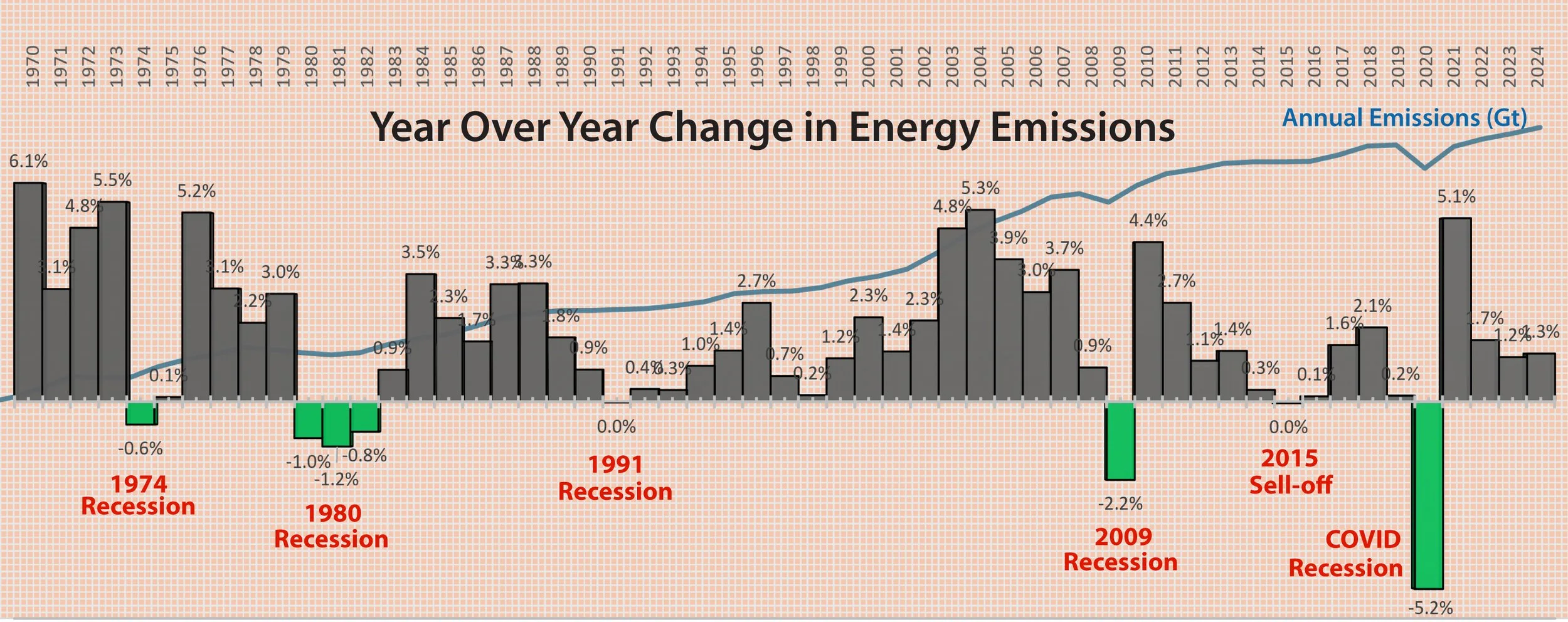Blogs & Webinars
Consumption Drives Climate—the Onus is On Us (October 2025)
The UN Climate Summit and Climate Week NYC concluded in New York, but without any timely action on carbon emissions. We’re back to a wing and prayer. “Electrification” and “Clean Energy” are still the current buzzwords, “Adaptation” and “Remediation” the plans, and scrubbing carbon dioxide from the atmosphere—if even feasible—will be our future cure-all. Unfortunately, annual emissions have increased every year for more than 50 years, except during global recessions—a noteworthy correlation. The COVID economic slowdown cut global emissions by 1.8 billion metric tons in 2020, more than a five percent decrease. The 1980 recession accounted for a cumulative savings of more than six percent for three years relative to 1979. Emissions decreased in the recessions of 1974, 1991 and 2009 as well. The tie between consumer consumption and emissions is undeniable—especially for the carbon footprint of purchases and activity. A correlation to consider.
How to Lower Embodied Carbon Construction & Slow Global Warming—Proforma vs Proformative Actions (February 2025).
Sound building design can reduce Embodied Carbon even lacking sufficient Life Cycle Analysis data and tools.
This video addresses reality. How building design and construction materials accelerate Climate Change. How simply meeting building code proforma and low-carbon policy is not enough. Smart low-carbon design is required. See how building designs can ignore embodied emissions, and how unreliable Environmental Product Declaration (EPD) data can defeat low-carbon building material selection. Watch this short-course on how to cut embodied carbon immediately.
Opening Keynote for AIA LA’s 7th Climate Change Symposium (2024)
AIA LA’s 1.5C Symposium on Climate Change Keynote 2024
April 19, 2024: Full Day Conference on Minimizing Embodied Carbon
AIA LA’s 1.5C Symposium on Climate Change 2024
Comments to the EPA Low-Embodied Carbon Initiatives
Elaborative comments to the EPA Low-Embodied Carbon Initiatives submissions by Bill Caplan, author of Thwart Climate Change Now: Reducing Embodied Carbon Brick by Brick
Meaningful Climate Action—Requires Consumer Action Too
Climate action funding in the Inflation Reduction Act (I.R.A.) is a giant leap for humankind. However, we need small steps from each of us to prevent it from faltering. The wheels of government turn slowly, as do enacting legislation and building infrastructure. It’s up to all of us to stabilize emissions in the meantime—
Advocacy or Action?
3 interesting questions on AIA Committee on The Environment (COTE) forum about the potential impact from the world’s 1.3 million architects:
One architect expressed that architects are "not" in a position to impact embodied carbon significantly over the next ten years by championing specific materials for their projects. He stated that “More important is our advocacy with our elected leaders and governments: significant changes in the amount of embodied carbon in the built environment will only come through government regulation, i.e. changes to the building codes . . .”
Reducing Embodied Carbon—to Reduce Global Warming
Webinar:
Nearly, 40% of all, energy-related emissions worldwide arise from the construction, and operation of buildings. The built environment is our largest source of energy-related Climate Changing emissions. Everyone connected with the design, construction or development of buildings or infrastructure can help. Consequences from what we build today, from the next project, will persist for the next 50 to one-hundred years or more. Protecting our most valuable resource.
How Small Building Design Impacts Embodied Emissions
The sheer number of small buildings worldwide illuminates an opportunity to control the destiny of carbon emissions through the practice of informed design – a rather striking opportunity. Not only do residential dwellings comprise the largest share of small buildings, residences constitute the largest number of ‘all’ buildings worldwide.









